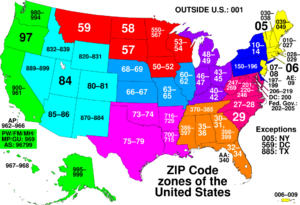ZIP code facts for kids
The ZIP code is a special system of numbers used by the United States Postal Service (USPS) to help sort and deliver mail. The letters ZIP stand for Zone Improvement Plan. This name was chosen because using these codes helps mail travel more quickly and efficiently.
A basic ZIP code has five numbers. There's also an extended version called ZIP + 4. This code adds a hyphen and four more numbers to the basic five. The ZIP + 4 code helps mail get to a very exact spot, even more specific than just the five-digit code.
Contents
How ZIP Codes Started
The postal service first used "postal zones" for big cities back in 1943. But by the early 1960s, they needed a better system for the whole country.
The First ZIP Codes
On July 1, 1963, the first ZIP codes were created for the entire United States. At first, using them wasn't required for everyone. But by 1967, they became mandatory (meaning you had to use them) for many types of mail. Soon after, the system was used for almost all mail.
What is ZIP + 4?
In 1983, the U.S. Postal Service introduced the expanded ZIP code system called "ZIP + 4." People sometimes call these "plus-four codes" or "add-on codes."
Here's an example:
- Wikimedia Foundation Inc.
- 200 2nd Ave. South #358
- St. Petersburg, FL 33701-4313
In this example, 33701 is the basic five-digit ZIP code, and 4313 is the "+ 4" part.
A ZIP + 4 code uses the first five numbers plus four extra digits. These extra numbers help identify a smaller area within the main five-digit zone. This could be a group of apartments, a specific building, or a place that receives a lot of mail. It helps mail get to its exact destination faster!
How ZIP Codes Are Organized
ZIP codes are numbered in a special way. The first number tells you which group of U.S. states the mail is going to. The second and third numbers narrow it down to a specific region within that group, or sometimes a large city. The fourth and fifth numbers then point to a group of delivery addresses inside that region.
Often, the main town in a region gets the first ZIP codes for that area. Other towns usually get their ZIP codes in alphabetical order.
Here's what the first digit of a ZIP code means:
- 0 = Connecticut (CT), Massachusetts (MA), Maine (ME), New Hampshire (NH), New Jersey (NJ), Puerto Rico (PR), Rhode Island (RI), Vermont (VT), Virgin Islands (VI), APO Europe (AE), FPO Europe (AE)
- 1 = Delaware (DE), New York (NY), Pennsylvania (PA)
- 2 = District of Columbia (DC), Maryland (MD), North Carolina (NC), South Carolina (SC), Virginia (VA), West Virginia (WV)
- 3 = Alabama (AL), Florida (FL), Georgia (GA), Mississippi (MS), Tennessee (TN), APO Americas (AA), FPO Americas (AA)
- 4 = Indiana (IN), Kentucky (KY), Michigan (MI), Ohio (OH)
- 5 = Iowa (IA), Minnesota (MN), Montana (MT), North Dakota (ND), South Dakota (SD), Wisconsin (WI)
- 6 = Illinois (IL), Kansas (KS), Missouri (MO), Nebraska (NE)
- 7 = Arkansas (AR), Louisiana (LA), Oklahoma (OK), Texas (TX)
- 8 = Arizona (AZ), Colorado (CO), Idaho (ID), New Mexico (NM), Nevada (NV), Utah (UT), Wyoming (WY)
- 9 = Alaska (AK), American Samoa (AS), California (CA), Guam (GU), Hawaii (HI), Marshall Islands (MH), Federated States of Micronesia (FM), Northern Mariana Islands (MP), Oregon, Palau (PW), Washington (WA), APO Pacific (AP), FPO Pacific (AP)
Related pages
Images for kids
See also
 In Spanish: Código ZIP para niños
In Spanish: Código ZIP para niños





